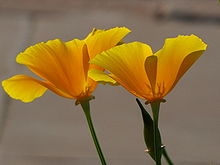October 12, 2012 5:27 pm • DENISE SEGHESIO LEVINE

This is your chance to find plants that are native to the county, and the diversity may surprise you.
This year, the Native Plant Society has more than 1,000 different varieties of plants for sale. Whether you are looking for winter color, drought tolerance, deer resistance or another manzanita for your collection, you will probably find suitable choices at Skyline Park this weekend.
So how to decide? Native Plant Society member Kendra Baumgartner, a plant pathologist with the UC Davis, has grown many natives in her garden and has several favorites.
Bumblebees and hummingbirds are attracted to the bright red blossoms of California fuchsia (Zauschneria californica). This plant produces abundant trumpet-shaped flowers, does well in full sun, spreads easily by roots and is very drought tolerant.
Another colorful, drought-resistant bumblebee favorite that performs well in sun is flannelbush (Fremontodendron californicum). Flannelbush has big, tropical-looking yellow flowers, and it matures into a small tree. At the Martha Walker Native Habitat Garden in Skyline Park, you can see what flannelbush and other native plants look like and how large they grow.
To attract wild and domestic honeybees, consider wild or California lilac (Ceanothus spp.), which flowers in white, purple or blue. For a drought-resistant ground cover in a spot with full sun, choose C. gloriosus porrectus or C. prostratus. Blue beauties like C. ‘Frosty Blue’ and C. ‘Dark Star’ reach six feet tall or more. If you have a large garden, consider C. ‘Ray Hartman,’ which grows up to 18 feet tall.
Looking for color in a shady spot? For red blossoms in full or partial shade, Kendra suggests spice bush (Calycanthus occidentalis). Spice bush needs more water than some natives, since its natural habitat is normally in riparian areas. In addition to its unique, dark red blossoms in spring, spice bush offers the benefit of its spicy fragrance, which the thick, dark green leaves release when brushed or crushed.
Blue-eyed grass (Sisyrinchium bellum) is an herbaceous plant, but it is called a grass because it has blade-shaped leaves that grow in tufts. It spreads by roots, does well in full to partial sun and is drought tolerant. The plant takes its name from its little blue flowers with bright yellow centers, which appear in spring and summer.
Deer grass (Muhlenbergia rigens) is a big bunch grass that grows up to two feet tall. It can be hacked to the ground in winter, and it appreciates regular trimming during the growing season to keep it from looking too wild. In Kendra’s garden, dragonflies perch on the upper leaves, while sparrows take shelter under the canopy of leaves that drape to the ground.
Snowberry (Symphoricarpus albus) is another riparian woodland shrub that matures into a low bush with pretty, delicate leaves and tiny pink flowers. Snowberry produces large white berries in winter, an important food source for birds.
The Native Plant Society has at least nine different manzanita varieties available, from Arctostaphyolos uva-ursi ‘Pt. Reyes,’ a ground cover that stays below two feet in height, to A. ‘Dr. Hurd,’ a manzanita that can grow 10 feet tall. Manzanita is a popular plant in Napa County, for good reason. It has beautiful bark in red, tan and brown and tiny pink or white bell-shaped flowers in spring.
If you have room for a medium to tall tree in full or partial sun, take a look at the blue oaks for sale (Quercus douglasii). Blue oaks have beautiful blue-gray leaves that they drop in winter to reveal draping branches that are a favorite perch for songbirds (and, as Kendra warns, for the Cooper’s hawks that eat them). Blue oaks are drought tolerant once established.
Studies show that fall-planted perennials develop more drought resistance. They get off to a good start in warm soil and then have all winter to develop a deep, strong root system. While most plants need to be watered diligently during their first growing season, fall-planted perennials typically need less water for less time than their spring-planted counterparts.
The California Native Plant Society, Napa Chapter, sale took place Saturday, October 13, 2012 and Sunday, October 14, 2012 from 10 a.m. to 4 p.m. both days. While you are at the sale, pick up some information about the California Native Plant Society. This organization is an excellent resource for information about plants in our area. Consider becoming a member so that you can learn through working with them. Getting to know the plants around us and understanding their natural habitat adds richness to our lives in Napa County.